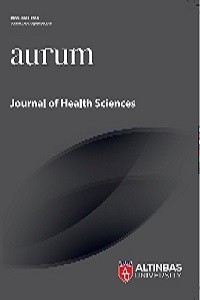POLİKİSTİK OVER SENDROMLU HASTALARDA LABORATUVAR VE KLİNİK BULGULARIN İNCELENMESİ
Arka plan/amaç: Polikistik over sendromlu (PKOS) hastaların kan parametrelerini ve klinik özelliklerini incelemek.
Gereç ve yöntem: Afyon Devlet Hastanesi Kadın Hastalıkları ve Doğum Polikliniği'ne Mart 2019-Haziran 2021 tarihleri arasında başvuran PKOS tanılı 200 hasta retrospektif olarak incelendi. Poliklinik şikayetleri, vücut kitle indeksleri, insülin direnci varlığı not edildi. Homeostatik Model Değerlendirmesi (HOMA) indeksine ve hormon profillerine göre.
Bulgular: PKOS hastalarının yaş ortalaması 25,0±4,3, vücut kitle indeksi ortalaması 24,8±3,7 kg/boy (m2) idi. HOMA'ya göre (n=31) hastaların %31'inde insülin direnci vardır. Kadın hastalar adet düzensizlikleri nedeniyle kliniğe sıklıkla başvurmaktaydı. Hastaların %15'inde yüksek prolaktin seviyeleri kaydedildi. hastaların %10'unda tiroid uyarıcı hormon seviyeleri yükselir.
Sonuç: Polikistik over sendromu genetik bir sorundur ve insülin direnci ile birlikte klinik semptomlara sahip olabilir. Hastalarda jinekolojik semptomlar ve metabolik değişiklikler vardır. PKOS tanısı alan hastalar, yaşamları boyunca oluşabilecek riskler konusunda tam olarak bilgilendirilmeli ve eğitilmelidir. Tıbbi tedaviye ek olarak, hastalar egzersiz yapmalı ve uygun bir diyet yapmalıdır.
Anahtar Kelimeler:
İnsülin direnci, metabolik hastalık, polikistik over sendromu
STUDY OF LABORATORY AND CLINICAL FINDINGS IN PATIENTS WITH POLYCYSTIC OVARY SYNDROME
Background/aim: To study blood parameters and clinical features of patients with polycystic ovary syndrome (PCOS).
Materials and methods: We retrospectively studied 200 patients diagnosed with PCOS admitted to the Obstetrics and Gynecology Outpatient Department of Afyon State Hospital between March 2019 and June 2021. We noted the complaints of the outpatient clinic also their body mass indexes, the presence of insulin resistance according to the Homeostatic Model Assessment (HOMA) index, and their hormone profiles.
Results: The mean age of the PCOS patients was 25.0±4.3 years, and the mean body mass index was 24.8±3.7 kg/height (m2). According to HOMA (n=31), 31% of patients have insulin resistance. Female patients frequently visited the clinic because of menstrual irregularities. Elevated prolactin levels were noted in 15% of patients. thyroid-stimulating hormone levels are elevated in 10% of the patients.
Conclusion: Polycystic ovary syndrome is a genetic problem and may have clinical symptoms with insulin resistance. Patients have gynecological symptoms and metabolic changes. Patients diagnosed with PCOS should be fully informed and educated about the risks that may occur during their lifetime. Additional to medical treatment, patients should exercise and have a proper diet.
___
- Falcetta, P., Benelli, E., Molinaro, A., Di Cosmo, C., Bagattini, B., Del Ghianda, S., ... & Tonacchera, M. (2021). Effect of aging on clinical features and metabolic complications of women with polycystic ovary syndrome. Journal of Endocrinological Investigation, 44(12), 2725-2733.
- Fux Otta, C., Wior, M., Iraci, G. S., Kaplan, R., Torres, D., Gaido, M. I., & Wyse, E. P. (2010). Clinical, metabolic, and endocrine parameters in response to metformin and lifestyle intervention in women with polycystic ovary syndrome: a randomized, double-blind, and placebo control trial. Gynecological Endocrinology, 26(3), 173-178.
- Giallauria, F., Palomba, S., Maresca, L., Vuolo, L., Tafuri, D., Lombardi, G., ... & Francesco Orio. (2008). Exercise training improves autonomic function and inflammatory pattern in women with polycystic ovary syndrome (PCOS). Clinical endocrinology, 69(5), 792-798.
- Kabakchieva, P., Georgiev, T., Gateva, A., Hristova, J., & Kamenov, Z. (2021). Polycystic ovary syndrome and (pre) osteoarthritis: assessing the link between hyperandrogenism in young women and cartilage oligomeric matrix protein as a marker of cartilage breakdown. Clinical Rheumatology, 40, 4217-4223.
- Karavani, G., Chill, H. H., Schachter-Safrai, N., Lomnitz, G., Gillis, D., & Bauman, D. (2021). Gonadotropin releasing hormone analogue treatment of central precocious puberty is not associated with altered prevalence of polycystic ovary syndrome: a single center cohort study. Clinical Diabetes and Endocrinology, 7, 1-6.
- Karimi, E., Moini, A., Yaseri, M., Shirzad, N., Sepidarkish, M., Hossein-Boroujerdi, M., & Hosseinzadeh-Attar, M. J. (2018). Effects of synbiotic supplementation on metabolic parameters and apelin in women with polycystic ovary syndrome: a randomised double-blind placebo-controlled trial. British Journal of Nutrition, 119(4), 398-406.
- Kayacık Günday, Ö., Özdemir Erdoğan, M., Pehlivan, A., & Yılmazer, M. (2022). The effect of metformin treatment on leukocyte telomere length in patients with polycystic ovary syndrome: a prospective case–control study. Journal of Assisted Reproduction and Genetics, 39(9), 2153-2161.
- Mizgier, M., Jarząbek-Bielecka, G., Wendland, N., Jodłowska-Siewert, E., Nowicki, M., Brożek, A., ... & Opydo-Szymaczek, J. (2021). Relation between inflammation, oxidative stress, and macronutrient intakes in normal and excessive body weight adolescent girls with clinical features of polycystic ovary syndrome. Nutrients, 13(3), 896.
- Naumova, I., Castelo-Branco, C., Kasterina, I., & Casals, G. (2021). Quality of life in infertile women with polycystic ovary syndrome: a comparative study. Reproductive Sciences, 28(7), 1901-1909.
- Nekooi, M., Bazarganipour, F., Zoladl, M., Heshmat, R., Aramesh, S., & Hosseini, N. (2022). Effect of Acupressure on Health-Related Quality of Life in Patients with Polycystic Ovarian Syndrome: A Randomized Clinical Trial. Evidence-Based Complementary and Alternative Medicine, 2022.
- Robinson, S., Kiddy, D., Gelding, S. V., Willis, D., Niththyananthan, R., Bush, A., ... & Franks, S. (1993). The relationship of insulin insensitivity to menstrual pattern in women with hyperandrogenism and polycystic ovaries. Clinical endocrinology, 39(3), 351-355.
- ISSN: 2651-2815
- Yayın Aralığı: Yılda 3 Sayı
- Başlangıç: 2018
- Yayıncı: Altınbaş Üniversitesi
Sayıdaki Diğer Makaleler
Dekspantenol içeren nemlendirici kremin optimizasyonu ve değerlendirilmes
Arkan Yashar BARBAR, Mohammed KAKAYİ, Buket AKSU
KOMPLİKE KRON KÖK KIRIKLARI: İKİ OLGU SUNUMU
Behiye BOLGÜL, Rukiye ARIKAN, Oyku PEKER
POLİKİSTİK OVER SENDROMLU HASTALARDA LABORATUVAR VE KLİNİK BULGULARIN İNCELENMESİ
Musa BÜYÜK, Nagihan KARACAR BÜYÜK, Kamuran SUMAN, Havva KUŞCU, Ebru GÖK, Murat SUMAN
SAĞLIK YÖNETİM SİSTEMİNDE DİJİTALLEŞME VE ÜST YÖNETİMDEKİ YENİ ÜYE: DİJİTAL DÖNÜŞÜM LİDERİ
